We are pleased to announce an exciting new alliance between Active Living Research and GP RED to co-host and coordinate...
Factors Associated with Bicycling to High School in Davis, CA

Presentation at the 2010 Active Living Research Annual Conference
Background:
Children in the U.S. are walking and bicycling to school at much lower rates today than in the past, a trend that has contributed to declines in physical activity and increases in obesity. Although many recent studies examine walking to school for elementary school students, few studies have focused on bicycling or on high-school students. Prior research suggests that three sets of factors may influence the decision of high school students to bicycle: individual factors, including age, gender, driver’s license, and access to a car, as well as attitudes toward bicycling, comfort with bicycling, concern for the environment, sensitivity to social pressures, etc.; social environment factors, including peer influences, parental influences, and community influences; and physical environment factors, such as distance from home to school, quality of bicycle infrastructure, and availability of bicycle parking. The City of Davis, CA, with high levels of bicycling compared to other U.S. cities, offers a unique setting for examining factors associated with bicycling to high school.
Objectives:
To identify factors associated with bicycling to high school.
Methods:
The study uses a cross-sectional design. Data are from a survey of students at Davis High School, which serves grades 10 through 12. A 2-page survey instrument was developed in conjunction with students in the Environmental Club at Davis High. The survey included measures of usual mode of travel to and from school, 33 agree/disagree statements, and questions on demographic characteristics. Club members distributed surveys to every class except physical education classes during 4th period on April 15, 2009; students completed the surveys during class; and club members collected the completed surveys at the end of the period. The response rate was 83.4%, with 1363 completed surveys out of 1634 enrolled students.
Results:
Of 1302 valid responses, 432 students or 31.7% usually bicycle to school, while 870 or 63.9% do not. Demographic differences are significant: 26.2% of girls bicycle compared to 41.2% of boys; 39.7% of 10th graders bicycle compared to 33.0% of 11th graders and 21.3% of 12th graders. Initial bivariate analysis shows significant differences between students who bicycle and those who don’t for individual, social-environment, and physical-environment factors. Individual factors include “I like being physically active,” “I am confident in my bicycling ability,” and “Protecting the environment is important to me,” with positive effects on bicycling; negative factors include “The clothes I wear make it hard to ride a bicycle,” “I hate wearing a bicycle helmet,” and “I like being driven places.” Social-environment factors include both peer influences (“I worry what my peers will think of me if I bike to school”) and parental influences (“One or both of my parents/guardians bicycle frequently”). Physical-environment factors are also associated with bicycling, particularly “I live too far away from school to bicycle here” with a negative effect, and “There is a direct bicycle route from my home to school” with a positive effect. Multivariate analysis will be used to test the relative importance of these factors while controlling for others.
Conclusions:
The results suggest that a supportive physical environment is not enough to encourage students to bicycle to high school. Strategies to increase bicycling among high schools students must target individual attitudes and constraints, peer influences, and parental influences as well.
Support:
This project was supported by a grant from the Sustainable Transportation Center, which receives funding from the U.S. Department of Transportation and Caltrans, the California Department of Transportation, through the University Transportation Centers program.
STAY UP TO DATE
RECENTLY ADDED TOOLS & RESOURCES
MOVE! A BLOG ABOUT ACTIVE LIVING
The "Active Living Conference" aims to break down research and practice silos and...







